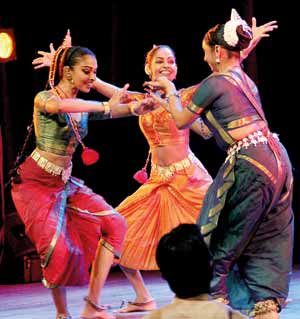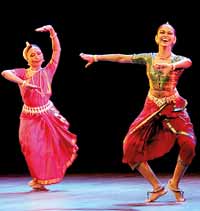The Nrityagram Dance Ensemble returned to Sri Lanka with a new and innovative programme – “the braid,” fresh from a very successful tour of Mexico and the United States. Much has been written about the impact of this particular performance by many well known dance critics in the U S. Perhaps a measure of their success could be judged by the fact that Mikhail Baryshnikov, saw the show twice and then invited the whole cast for tea, he was so impressed with their performance.
| Dancereview |
Samhara :‘the braid’.The
Nrityagram dance ensemble in
collaboration with the Chitrasena
Vajira Dance Foundation at the
Lionel Wendt Memorial Theatre,
Colombo on May 12 and 13. |
The story behind “the braid”
Hitherto the Nrityagram dancers have closely followed the 2000-year-old traditions of Odissi, (the temple dance of Orissa), while innovating with choreography, costume, music and lighting to project the dance form into the 21st Century.
A historical and emotional tie, dating back to 2003 between the Nrityagram Ensemble, and the Chitrasena Kalayatanaya, eventually led to the performance of “Samhara”- the braid, which also means “drawing together.”
 |
| Odissi and Kandyan: Two dances in step. Pix by Indika Handuwala |
This is Nrityagram’s first international collaboration, which is a weaving together of two dance forms, not even remotely connected. The one, Odissi is lyrical, sensuous, fluid and completely feminine, while Kandyan Dance, the upcountry tradition of Sri Lanka is dynamic, unhesitatingly, and uncompromisingly masculine. Odissi uses the body’s plasticity, and the Tribanga pose as the basic platform, while an essentially straight backed, broad shouldered stance and a wide plie are the essence of the Kandyan style, not forgetting the signature airborne leaps and whirls. Accompanying music for Odissi is mellifluous -voice, flute, violin with a sweet sounding Mardala to interpret the intricate rhythms, while for Kandyan, the throbbing, forceful, heart stopping beats of the Getaberaya proclaim the dance.
When I first heard of this intended collaboration it was not conceivable that these two completely diverse styles could coalesce without compromise. With a great desire to see this process in action, I made a trip in February this year, to Nrityagram’s home, the Dance Village close to Bangalore to watch the creation of “Samhara”. I was completely in awe of what I saw and felt.
To watch Surupa Sen and her team at practice was a lesson in absolute concentration, dedication and singleness of purpose. Nothing, and no one existed outside of their movements, the steps, the poses, and the lines they were creating with their bodies, to the rhythms- streaming out of the drums. It was obvious to the handful of us who were privileged to watch, that we, and the surroundings had ceased to exist for them. It was only the dance and nothing else. While Surupa carried the ultimate vision in her head and created the Odissi movements, she conveyed her ideas and thoughts to Heshma for translation into the Kandyan technique. It was indeed a melding of ideas, styles, traditions and cultures, while not diluting or compromising either art form. It was truly amazing.
 It was this atmosphere, alive with the true spirit of dance that the very talented Thajithangani, grand-daughter of Chitrasena and Vajira along with her colleague Mithilani had the privilege of experiencing at Nrityagram. Watching them being directed by Surupa and interacting with this very dedicated group, it struck me that they had the opportunity of a lifetime. They are both young enough to absorb and emulate the work ethic, and sheer dedication, that goes to make great dancers. Both are at the threshold of their careers. Hopefully, this has been an immeasurable, life changing experience for them, creating a foundation on which to build and an example to follow. It was this atmosphere, alive with the true spirit of dance that the very talented Thajithangani, grand-daughter of Chitrasena and Vajira along with her colleague Mithilani had the privilege of experiencing at Nrityagram. Watching them being directed by Surupa and interacting with this very dedicated group, it struck me that they had the opportunity of a lifetime. They are both young enough to absorb and emulate the work ethic, and sheer dedication, that goes to make great dancers. Both are at the threshold of their careers. Hopefully, this has been an immeasurable, life changing experience for them, creating a foundation on which to build and an example to follow.
Samhara
The performance at the Lionel Wendt. consisted of four well chosen items, diverse in mood, theme and content.
Arpanam was a devotional piece, an invocation to Goddess Parvathi, essentially composed in the Odissi idiom; it also introduced the two Kandyan dancers in interplay of styles and steps. In the dance that followed the five elements were presented as a ritual offering to the Goddess. Both techniques were employed, and expressive hand, and body movements, intrinsic to each, described the Elements, very subtly. Particularly distinguishable were the characteristic movements of the majestic elephant, taken from the Gajaga Vannama, interwoven with the more sinuous interpretation in the Odissi genre.
Invoking Shiva as the God of dance and destruction had a Sri Lankan connection, as it was a hymn of praise attributed to Ravana. It was a strong forceful statement of the Shiva, Ravana worshipped. This was essentially masculine –Tandava, in mood, expression and movements, within the confines of the Odissi technique. Surupa chose to compose this as a duet. While Bijayini danced the tandava aspect, Surupa expressed the lasya. Bijayini’s skilful interpretation breathed fire. Subduing her own personality, she truly became the dance, while Surupa characteristically was absorbed into the softer elements of the song.
 In contrast, what followed was Krishna’s Lament, a lasya item, distinctly feminine and sensuous, portraying a range of emotions in the immortal love story of Krishna and Radha. It was a lyrical piece full of facial expression and passion, enhanced by the haunting voice of Jateen Sahu, supported by Srinibas on flute and Sanjib on violin. In contrast, what followed was Krishna’s Lament, a lasya item, distinctly feminine and sensuous, portraying a range of emotions in the immortal love story of Krishna and Radha. It was a lyrical piece full of facial expression and passion, enhanced by the haunting voice of Jateen Sahu, supported by Srinibas on flute and Sanjib on violin.
Surupa who danced this as a solo gave full rein to her expressive body, losing herself in the self- deprecating Krishna.
Alap, the final item was Samhara, the braid. It was a joyous exhilarating item, full of throbbing rhythms, fast paced movements, and the interweaving of techniques.The clever choreography gave the impression that there were many more dancers on stage than there actually were.
urupa Sen’s choreography and vision was brilliant. Her ability to translate her thoughts, into dance steps and rhythms, moods and movements, gestures and glances is truly a gift, which she has used to great effect. While the material she uses for her creativity is the human body - that she can mould it to any form is only the measure of the training that she and her co dancers of Nrityagram have pursued.
Bijayini, Surupa and Pavithra,have, for nearly two decades assimilated the powerful traditions of Odissi, to enable them to project and share their great art with the world. Protima Bedi, founder of Nrityagram, says in her autobiography, that she was “consumed by Odissi Dance”. After watching the performance, I can truly say the same of the Nrityagram Ensemble. They are “consumed by Odissi”. Perfection is what they have striven for: I can almost say they have arrived.
Thaji brings with her three generations of dance flowing through her veins and Mithilani, a structured course of training that has enabled her to hold her own. Both dance with the joyous abandon of youth, contrasting with the contained perfection of the Nrityagram trio.
No performance can succeed without a combination of inspired music, imaginative lighting and good sound, all of which were present. The musicians from India ably supported the Nritygram trio, while the getaberaya, played with skill and colour by Udaya Kumara, brought out the essence of Kandyan.
The intention of the composers that the two traditions of Odissi and Kandyan should meet in time and space has indeed been achieved. Emphasizing this similarity in diversity were the distinctive movements of the elephant and the peacock, danced simultaneously in Odissi and Kandyan styles.
Neither style was compromised; each retained its own integrity, while they coalesced into a seamless braid, each strand with its own colours. Samhara has successfully transcended the barriers of land and sea, tradition and culture, race and religion.
Perhaps in the end, we are truly one…………. |


 It was this atmosphere, alive with the true spirit of dance that the very talented Thajithangani, grand-daughter of Chitrasena and Vajira along with her colleague Mithilani had the privilege of experiencing at Nrityagram. Watching them being directed by Surupa and interacting with this very dedicated group, it struck me that they had the opportunity of a lifetime. They are both young enough to absorb and emulate the work ethic, and sheer dedication, that goes to make great dancers. Both are at the threshold of their careers. Hopefully, this has been an immeasurable, life changing experience for them, creating a foundation on which to build and an example to follow.
It was this atmosphere, alive with the true spirit of dance that the very talented Thajithangani, grand-daughter of Chitrasena and Vajira along with her colleague Mithilani had the privilege of experiencing at Nrityagram. Watching them being directed by Surupa and interacting with this very dedicated group, it struck me that they had the opportunity of a lifetime. They are both young enough to absorb and emulate the work ethic, and sheer dedication, that goes to make great dancers. Both are at the threshold of their careers. Hopefully, this has been an immeasurable, life changing experience for them, creating a foundation on which to build and an example to follow. In contrast, what followed was Krishna’s Lament, a lasya item, distinctly feminine and sensuous, portraying a range of emotions in the immortal love story of Krishna and Radha. It was a lyrical piece full of facial expression and passion, enhanced by the haunting voice of Jateen Sahu, supported by Srinibas on flute and Sanjib on violin.
In contrast, what followed was Krishna’s Lament, a lasya item, distinctly feminine and sensuous, portraying a range of emotions in the immortal love story of Krishna and Radha. It was a lyrical piece full of facial expression and passion, enhanced by the haunting voice of Jateen Sahu, supported by Srinibas on flute and Sanjib on violin. 